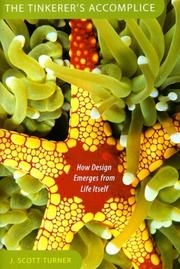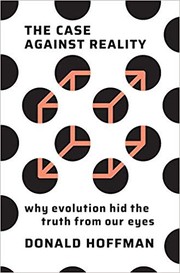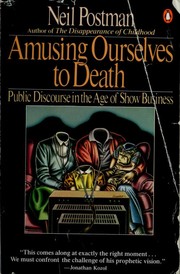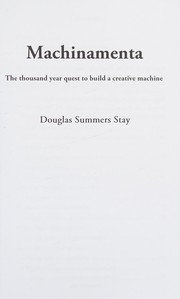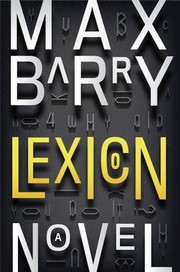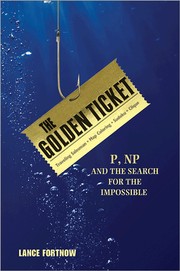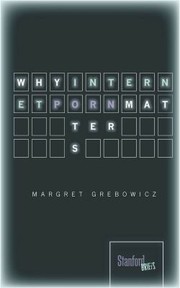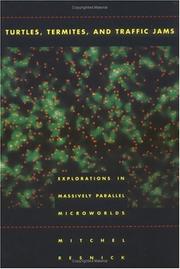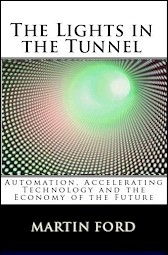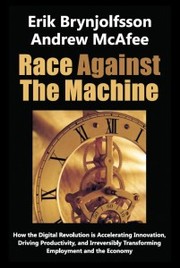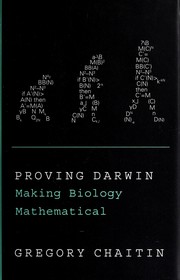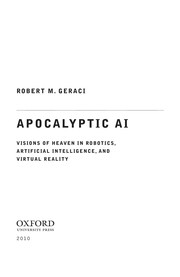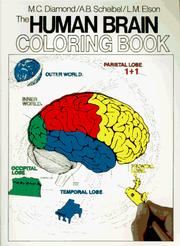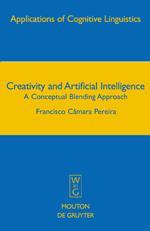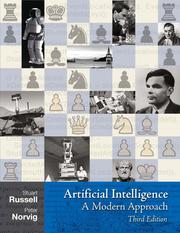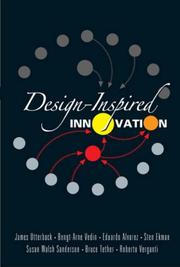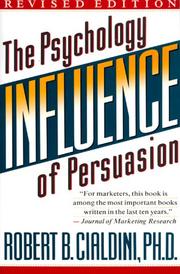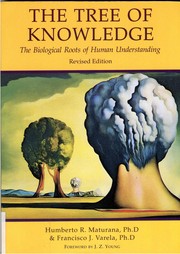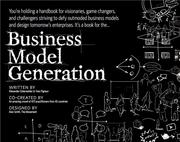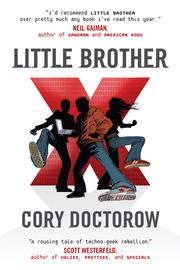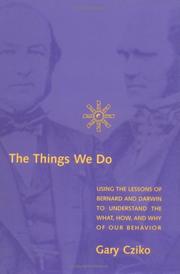The Tinkerer's Accomplice - How Design Emerges from Life Itself by Scott Turner - ISBN 0674023536 - Harvard University Press 2007
Motivation
Strengthening an hypothesis of creativity as an automated process that can thus be fully automatized or at least greatly supported through tools. Yet, without implying that the process itself arrived randomly but rather has an history and that consequently learning from biology is the most efficient if not the only way.
Pre-reading model
Draw a schema (using PmGraphViz or another solution) of the situation of the area in the studied domain before having read the book.
Reading
- Prologue
- thesis "organisms are designed not so much because natural selection of particular genes has made them that way, but because agents of homeostasis build them that way." (p1)
- 1 Cleanthes’ Dilemma
- design as "a peculiar harmony of structure and function in the devices organisms contrive to accomplish things." (p4)
- differentiating engineering and tinkering, Wikipedia:Francois Jacob
 's metaphor
's metaphor
- using juice box as an example of an object with a multiplicity of forms and changing through time
- developing tinkering as a process
- "adaptation is neither one thing [fit of the organism to its environment over generations] nor the other [physiological process to sustain immediate interaction with the environment, e.g. temperature]: it is the product of a conspiracy. The tinkerer has an accomplice." (p13)
- "nothing about evolution makes sense except in light of the physiology that underpins it." (p13)
- see also Wikipedia:Dialogues Concerning Natural Religion

- 2 Bernard Machines
- description of experiments of hard to predict air flows in termites mounts
- and the similarity of complexity across species
- "Despite the marked differences in architecture, differences that supposedly betokened very different types of ventilation, both chimney builders and mound builders ventilated their nests in essentially the same way, even down to wind being an important driver of the flows." (p20)
- "A living structure is not an object, but is itself a process, just as much so as the function that takes place in it." (p20-21)
- seems like a shift from OOP to functional programming
- especially as one of the main advantage of functional programming is to naturally allow for distribution of computations, something that large group of organisms with low computation ability would greatly benefit from
- see Seedea:Research/PhylogeneticFlowProgramming

- "the mound is not a physical structure for the function of ventilation, it is itself the function of ventilation: it is embodied physiology." (p21)
- "The mound is therefore more of a conveyor of soil than a repository of it, and this makes the mound a protean structure, its shape depending upon where, and by how much which process, soil deposition or soil erosion, prevails." (p21)
- protean from Wikipedia:Proteus
 as "versatile", "mutable", "capable of assuming many forms"
as "versatile", "mutable", "capable of assuming many forms"
- mention of isotherm, isobar and spherical structure as a normal way to gather the same level of resource from a source
- showing the direct link between a situation and a "solution" encountered independently, e.g. a circle around a fireplace
- "The lights began to go on for me when I realized that if termites did nothing more than convey soil from high-CO2 isobars to low-CO2 isobars, most of the mound’s interesting architectural features could be explained." (p24)
- "The mound captures wind energy at a particular rate that is matched to the colony’s metabolism, which makes it an organ of homeostasis." (p25)
- quoting Claude Bernard key expression "la fixité du milieu intérieur"
- Cosma Shalizi coined Bernard Machine
- "The idea of the Darwin machine was originally conceived by William Calvin as a way of thinking about thinking, the continual “throwing out” of thoughts until the “right one”—one that matches reality—emerges." (p27-28)
- 3 The Joy of Socks
- on the role of Wikipedia:Fibroblast
 (p32) and being "agents of tensions homeostasis" (p34)
(p32) and being "agents of tensions homeostasis" (p34)
- "All boil down to some optimization of strain that can be brought about by fibroblasts that act like Bernard machines" (p43)
- explaining the fiber angles through the shape and the strain they receive
- more generally, see Wikipedia:Epithelium

- 4 Blood River
- on vessels and network of deliveries at large, see also the work on power law in nature by Geoffrey West at SFI
- the architecture of efficiency through contradicting constraints
- mention of stigmergy (p66)
- 5 Knowledgeable Bones
- like in the previous chapter, multiple constraints have to be taken into account while trying to model the structure
- not simply its current state against load but also development, peak usage, etc
- explaining how Wikipedia:Osteon
 (aka Haversian system) are build on Wikipedia:Osteocyte
(aka Haversian system) are build on Wikipedia:Osteocyte
- "However the strain is sensed, the osseous internet confers on bone an inherent computing power that enables the osteocytes to collectively solve large-scale problems of integration and management of strain." (p78)
- talking about an "osseous network"
- Much of what we identify as intentionality in ourselves—past memories of what worked and what didn’t, new mental associations that underlie creative “new solutions,” and the building of novel structures that reflect these assessments—are present here, even if the conscious awareness of it is not." (p87)
- 6 Embryonic Origami
- "Beneath the skin churns an amazingly sophisticated system of hardware and software: gears and cogs of muscle and bone, systems of fuel and oxidant delivery, neuromuscular systems of tracking and guidance." (p88)
- a hardware/software metaphor potentially risky, only questioned later on during Chapter 10 page 198
- "organisms are resistant to being divvied up into mere assemblages of parts." (p90) as they form an interacting system
- see also TreeOfKnowledge on ontogenesis
- also on autopoeisis, autonomy and growing in complexity, i.e. metacellular
- no mention of Varela or Maturana
- no mention of ontogensis or corticogenesis
- "Though animals might appear to be solid three-dimensional creatures, they are, in reality, sheets of cells that are folded up in complex ways, like origami swans." (p93)
- "consider what may be the oldest physiological function: homeostasis of cell volume." (p93)
- several examples of the first animals and of their very simple sheet-like structures
- note that the apparent simplicity has to be put back into context, since the competition then was also simple advantages have to be calibrated too
- specific vocabulary
- e.g. value-added physiology, exploiting newfound opportunities, physiological innovation
- "Homeostasis involves ongoing physiological work, sustaining a flow of energy and matter: matter to rebuild the complicated molecules that are always degrading and the energy needed to impose orderliness on them. This ongoing work is called the metabolic demand." (p106)
- "Meeting the metabolic demand means the organism must commandeer an ongoing flow of matter and energy across the boundary that delimits it from its surroundings. This is called the physiological capacity." (p106)
- "the matching of demand and capacity over a range of body sizes involves scaling them both to a fractional dimension: in other words, it is fractal" (p111)
- 7 A Gut Feeling
- "net energy yield: energy revenues from a meal minus its energy costs."(p117)
- "there is also an optimum retention time that maximizes the net rate of return—keeping the energy streaming in as fast as possible." (p117)
- "Because animals live in competitive environments just as businesses do, feeding and the guts that process meals should be shaped by this bottom line, just as profit-driven companies are." (p117)
- "Taken as a whole, then, gut design appears to be the consequence of multiple and competing agents of homeostasis." (p134)
- 8 An Intentional Aside
- "Breaking free will mean that Darwinism can no longer treat intentionality as an irrelevant neumenon, as its Neo-Darwinist offspring insist it is, but must embrace it as a phenomenon." (p138-139)
- "Darwinism is, in fact, itself founded on the successful conversion of a long-standing neumenon - the species - into a phenomenon worthy of scientific inquiry. It is this conversion, more than the ingeniously simple but arguably long-anticipated doctrine of natural selection itself, that truly underscores Charles Darwin’s genius." (p139)
- could this be common to most if not all paradigm shift?
- should this also be conducted for creativity in general?
- philosophical distinction between Eidos and atomists
- history of classification, from dichotomy to quinarianism (from the five platonic solids) to the Linnean system
- see also the classical article What is it like to be a bat? by Wikipedia:Thomas Nagel
 , Philosophical Review, 1974 seen during SC02
, Philosophical Review, 1974 seen during SC02
- "science is about converting neumena into phenomena so objective answers can be had from them." (p149)
- a rather straightforward epistemology
- "intentionality is itself a form of homeostasis." (p149)
- 9 Points of Light
- "Epithelia divide worlds into new environments, and novel physiology can emerge from homeostasis being imposed upon these self-created environments." (p152)
- "Epithelia also create new environments within themselves, however, and novel physiology can emerge from imposing homeostasis there as well." (p152)
- homeostasis could thus be used as a constraints to limit the set of possible solutions to a problem, and this recursively across the network of homeostatic functions (as individuals)
- it could also be used to predict what will not be possible to build thus were expectations are vain, a theoretical creativity upper bound
- describing the retina and the physiological and computational problems it creates
- "This way is hard because representing the edge requires lots of data, lots of memory to store it, and lots of computations to handle it. The easier way is to reduce the many pixels marking the edge into a short line with a particular orientation." (p165)
- seems particularly coherent with WithoutNotesApril11#AndrewNg saw earlier this month
- note that Andrew Ng also cites the Wikipedia:Torsten Wiesel
 /Wikipedia:David H. Hubel
/Wikipedia:David H. Hubel architecture
architecture
- vision seems to be a particularly interesting challenge for machine learning precisely because it is so computationally costly
- i.e. if you can solve it, then solving the other senses and their related problem should be "easy"
- "As in the other designed systems considered in this book, it is largely the rough outlines of a structure that are specified by genes. Design only emerges when systems of Bernard machines get busy to remodel this “rough draft,” refining it into a well-functioning structure. So it appears to be in the visual system." (p176)
- defining neuronal pruning in corticogenesis as the "Great Culling"
- which would then not be a Darwinian process as proposed by Cziko (especially in WithoutMiracles#Chapter5) and others but rather an homeostatic process
- brief discussion of self-limiting excitation signals, especially in the womb
- aka Retinal waves
- see discussion with Raphael on the bank of the Marne regarding early development
- 10 Pygmalion’s Gift
- on yearning and how the body requires suffering alleviation resulting in pleasure chemistry in the brain
- defining Hedonostasis (p185) as "regulation of levels of felt pleasure."
- "an emergent consequence of a complicated set of interactions among lower-level systems of Bernard machines—in this case populations of nerve cells spread throughout the brain that seek to regulate, not pleasure, but levels of excitation." (p186)
- mention of experiment on mouse and the danger of not regulating, becoming "super-hedonist"
- "The penumbra of bad choices an addict makes is only explicable if the addict’s mental representation of the world is so distorted that taking the drug actually seems to be the rational choice." (p189)
- cognition defined as "the assembly of coherent mental representations of the world." (p189)
- "interactions between nerve cells that more closely resemble the complex suites of defense and aggression that characterize the co-evolution of predators and their prey" (p198)
- "exuberant, and seemingly pointless, diversity is a hallmark of evolutionary arms races." (189)
- "intentionality simply means that actions are explicitly geared toward creating some future or other abstract state." (p200)
- clarifying the distinction between intention as aiming to change a future state and "prediction-in-disguise"
- later "Intentionality arises when a discrepancy between the real world and the mental world is resolved by work being done to make the real world correspond to the mental world." (p204)
- see also BehindTheMirror and imprinting
- "The boundary between intentionality and prediction-in-disguise is a fuzzy one, obviously, but it seems to turn crucially on the nature of creativity." (p201)
- "Highly creative people also seem to have more permissive brains than the more ordinary among us." (p202)
- one could also consider the fine line between strict binding and lose binding a form of homeostatis as "Creative geniuses typically possess the cognitive and meta-cognitive resources to keep any pathologic tendencies in check.", Dean Keith Simonton page 229 of TheDarkSideOfCreativity#Chapter12
- "Homeostasis comes in because creative brains are also perturbed brains. A new association is a stressful event, a disruption of brain ecology." (p202)
- see ClickingMoments#Neurochemistry
- "I remember vividly that it was quiet relief that I felt, not excitement or joy. Perhaps that is the emotional correlate of the passing of the mental storm that is produced when the “real” world and a mental representation of it do not conform." (p203)
- see my own view assimilating this phenomenon to highly compressed information stabilizing by passing a multitude of reality check and also providing a boost in estimated chance of survival, cf ClickingMoments
- "A mathematical proof, a new theory, a painting, a new business model, all are ways of bending the world to how we view it rather than simply letting the world tell us how it is." (p203)
- "Pygmalion’s gift—we can imagine new worlds and intentionally make them real." (p203)
- 11 Biology’s Bright Lines
- mentioning the Central Dogma of Molecular Biology (p207)
- heredity and function
- explaining prion
- using play script as examples of the complexity of DNA expression mechanisms
- "Genes do not specify function: rather gene and function are more of a correlation, which, like all correlations, is indifferent to the direction of causation. This opens the door to innumerable ways the cell’s catalytic milieu can feed back and modulate the correlation." (p216)
- "Processes have a dimension of timeliness that objects lack: they are properly quantified as rates." (p218)
- defining persistors as "persistent environments created and managed by systems of Bernard machines." or "process-oriented memory", "not extended phenotype, but extended physiology." (p219)
- to oppose to object-oriented replicators
- the Internet might be currently the human society most pervasive yet tangible persistor
- can this very wiki, in particular with the multiple memory oriented tools (MemoryRecipe, MemoryRecalls, MemoryLoss, MemoryLossPES) be considered a personal persistor?
- (p220)
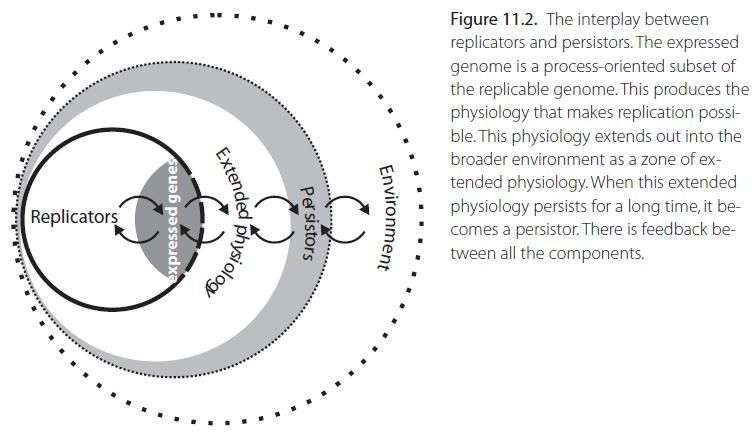
- to compare to the drawing done on the door at Langrolay
- "for a created environment to be a persistor, it must be longer lived than the Bernard machines that construct it." (p220)
- example of Wikipedia:Heuweltjie
 , some being dated as old as 4 000 years
, some being dated as old as 4 000 years
- "The heuweltjie is as much a hereditary legacy of past generations as are the genes contained within the termites’ cells." (p224)
- "persistent physiology may be life’s most primitive form of heritable memory, and this means that intentionality, at least of the form implied by homeostasis, may stretch back to the very origin of life." (p226)
See also
Overall remarks and questions
- no mention of Jakob von Uexkull, Cybernetics or Norbert Wiener
- has it been applied to design in general? for software? through a software facilitating this mindset or paradigm?
- could iterative or agile development be considered the closest thing to it?
- since it proposes a network of Bernard Machines interacting with each other and still through a framework of selection, what are the consequence for my own view on Mind? Should it be updated to better reflect that dynamism?
- are there genetic programming framework that take a developmental and fractal approach, thus initially building first a form of backbone that would only then support more finely grained components rather than directly trying to complete a final product?
- numerous examples from nature that solutions have to be good enough even during their development
- e.g. ontogenesis in general, nautilus shells, cuttlebone's chambers, etc
- also seems that a lot of optimization techniques based on physical principle (e.g. simulated annealing eventually even supported by quantum computers) are leveraging some sort of homeostatic mechanism
- repetitively moving from a disturbed state to a state of equilibrium
- overall for somebody physicalist but who also see importance in abstractions this thesis sounds like a great solution to many unifying problems
- how does Seedea:Content/Newconcepts#Chemoton
 confirm or infirm this view?
confirm or infirm this view?
- how does it compare with Wikipedia:Allostasis
 ?
?
Synthesis
So in the end, it was about X and was based on Y.
Critics
Point A, B and C are debatable because of e, f and j.
Vocabulary
(:new_vocabulary_start:)
stolid
avail
buoy
quarry
skein
shear
ensconced
epithelium
decussation
(:new_vocabulary_end:)
Post-reading model
Draw a schema (using PmGraphViz or another solution) of the situation of the area in the studied domain after having read the book. Link it to the pre-reading model and align the two to help easy comparison.
Categories
Back to the Menu
Other read books linking to the The Tinkerer's Accomplice page :
Back to the Menu
 Fabien Benetou's PIM
Fabien Benetou's PIM






